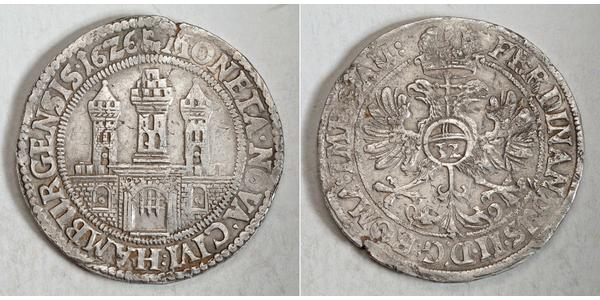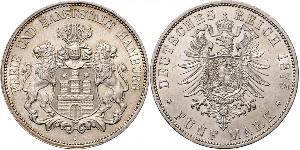1 Талер / 32 Шиллинг (продана за $720.0)
1626, Hamburg (Free Imperial City). Large Silver Thaler (32 Schilling) Coin.
Mint Year: 1626
Mint Place: Hamburg
Denomination: Thaler (32 Schilling)
Reference: Davenport 5365, KM-123.
Mint Official: Christoff Fuestel (privy mark: a hand holding mint-hook)
Condition: Minor planchet imperfection on edge, light deposits, some digs and scratches (possibly a landfind), otherwise a nicely centered XF!
Weight: 28.58gm
Diameter: 42mm
Material: Silver
Obverse: City walls with three towers and open gate.
Legend: (privy mark: a hand holdding mint-hook) MONETA . NOVA . CIVI : HAMBURGENSIS . 16Z6
Reverse: Imperial crown above double-headed eagle with cross-topped orb at chest, which contains schilling value (32). Titles of Emperor Ferdinand II around.
Legend: FERDINANDUS . II . D : G : ROMA : IMP : S : AU :
In 1189, by imperial charter, Frederick I "Barbarossa" granted Hamburg the status of a Free Imperial City and tax-free access (or free-trade zone) up the Lower Elbe into the North Sea. In 1265, an allegedly forged letter was presented to or by the Rath of Hamburg. This charter, along with Hamburg's proximity to the main trade routes of the North Sea and Baltic Sea, quickly made it a major port in Northern Europe. Its trade alliance with Lübeck in 1241 marks the origin and core of the powerful Hanseatic League of trading cities. On 8 November 1266, a contract between Henry III and Hamburg's traders allowed them to establish a hanse in London. This was the first time in history that the word hanse was used for the trading guild of the Hanseatic League. In 1270, the solicitor of the senate of Hamburg, Jordan von Boitzenburg, wrote the first description of civil, criminal and procedural law for a city in Germany in the German language, the Ordeelbook (Ordeel: sentence). On 10 August 1410, civil unrest forced a compromise (German: Rezeß, literally meaning: withdrawal). This is considered the first constitution of Hamburg.
In 1529, Hamburg embraced Lutheranism, and it received Reformed refugees from the Netherlands and France. When Jan van Valckenborgh introduced a second layer to the fortifications to protect against the Thirty Years' War in the seventeenth century, he extended Hamburg and created a "New Town" (Neustadt) whose street names still date from the grid system of roads he introduced.
Upon the dissolution of the Holy Roman Empire in 1806, the Free Imperial City of Hamburg was not incorporated into a larger administrative area while retaining special privileges (mediatised), but became a sovereign state with the official title of the Free and Hanseatic City of Hamburg.
Hamburg, officially Freie und Hansestadt Hamburg (Free and Hanseatic City of Hamburg), is the second largest city in Germany and the thirteenth largest German state. Its population is over 1.8 million people, and the Hamburg Metropolitan Region (including parts of the neighbouring Federal States of Lower Saxony and Schleswig-Holstein) has more than 5 million inhabitants. The port of Hamburg, on the river Elbe, is the second largest port in Europe (after the Port of Rotterdam) and tenth largest worldwide.
The official name reflects its history as a member of the medieval Hanseatic League, as a free imperial city of the Holy Roman Empire, a city-state, and one of the 16 states of Germany. Before the 1871 Unification of Germany, it was a fully sovereign state. Prior to the constitutional changes in 1919, the stringent civic republic was ruled by a class of hereditary grand burghers or Hanseaten.
Hamburg is a major transport hub and is one of the most affluent cities in Europe. It has become a media and industrial centre, with plants and facilities belonging to Airbus, Blohm + Voss and Aurubis. The radio and television broadcaster Norddeutscher Rundfunk and publishers such as Gruner + Jahr and Spiegel-Verlag are pillars of the important media industry in Hamburg. Hamburg has been an important financial centre for centuries, and is the seat of the world's second oldest bank, Berenberg Bank.

|
Добавил:
anonymous 2023-11-28 |
|
||
|
||
|
||
|
||
|
||




 Deutsch
Deutsch Русский
Русский Українська
Українська English
English Italiano
Italiano Français
Français Español
Español 汉语
汉语












